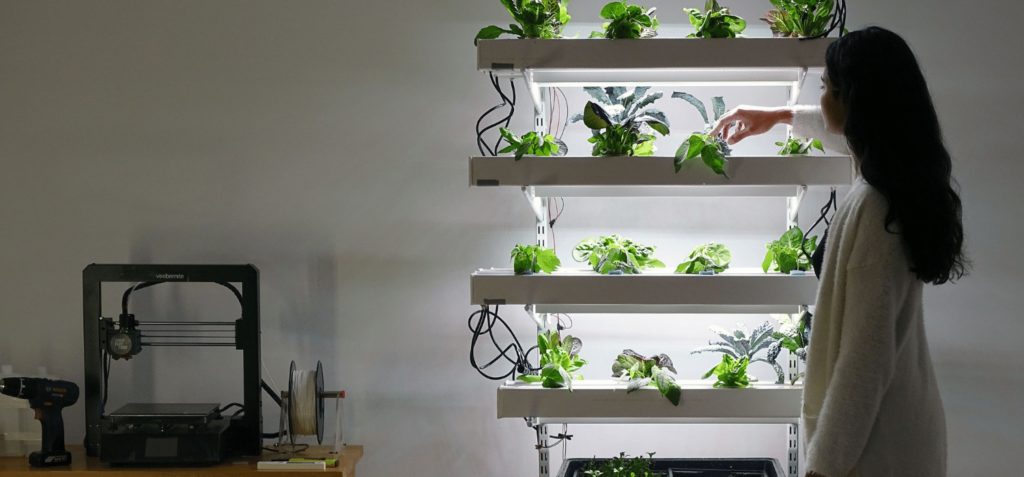Hydroponic farming has gained significant popularity in recent years due to its numerous advantages over traditional soil-based agriculture. In this comprehensive beginner’s guide, we will delve into the world of hydroponic farming, exploring its benefits, components, techniques, and future prospects.
The Benefits of Hydroponic Farming
Hydroponic farming offers a range of benefits that make it an attractive and sustainable option for modern agriculture. Compared to conventional methods, hydroponics utilizes water efficiently, requiring only a fraction of the water consumed in traditional farming. This water-saving feature is especially crucial in regions facing water scarcity.
Furthermore, hydroponic systems provide optimal nutrient delivery to plants, resulting in faster growth rates and higher yields. The absence of soil eliminates the risk of soil-borne diseases and allows for precise control over nutrient composition, ensuring plants receive the exact nutrients they need. Additionally, hydroponic systems can be implemented in small spaces, making it ideal for urban farming and maximizing land usage.
Key Components of a Hydroponic System
To understand hydroponic farming, it is essential to grasp the key components of a hydroponic system. These include a growing medium, nutrient solutions, water pumps, reservoirs, and pH control mechanisms. The growing medium, such as perlite, vermiculite, or rockwool, serves as a support structure for the plants’ root systems. Nutrient solutions, consisting of carefully balanced mineral mixes, provide the necessary elements for plant growth. Water pumps and reservoirs ensure proper circulation and delivery of nutrients, while pH control mechanisms maintain the optimal pH levels required by plants.

Types of Hydroponic Growing Techniques
Hydroponic farming offers a variety of growing techniques, each suitable for different plants and environments. Nutrient Film Technique (NFT) involves a thin film of nutrient-rich water flowing over plant roots, while Deep Water Culture (DWC) submerges the roots in a nutrient solution. Aeroponics suspends the plant roots in the air and delivers nutrients through misting, and Ebb and Flow systems intermittently flood and drain the root zone. Understanding these techniques allows farmers to choose the most appropriate method for their crops.
Nutrient Management in Hydroponic Farming
Proper nutrient management is crucial in hydroponic farming to ensure optimal plant growth and health. Essential nutrients required by plants include nitrogen, phosphorus, potassium, calcium, magnesium, and trace elements. Maintaining the correct nutrient composition and pH levels in the nutrient solution is essential for healthy plant development. Regular monitoring, adjustment, and replenishment of nutrients are necessary to achieve optimal yields and prevent nutrient deficiencies or imbalances.
Choosing Suitable Crops for Hydroponic Farming
Hydroponic farming is suitable for a wide range of crops, including leafy greens, herbs, tomatoes, cucumbers, strawberries, and even flowering plants. Leafy greens like lettuce and spinach are particularly popular due to their fast growth rates and high demand. Understanding the growth characteristics, nutritional requirements, and market demand for different crops helps farmers make informed decisions when selecting crops for hydroponic cultivation.
Setting Up a Hydroponic Farm
Setting up a hydroponic farm requires careful planning and consideration of various factors. Farmers must determine the space requirements, lighting conditions, temperature control, and ventilation for the hydroponic system. Quality equipment, such as grow lights, pumps, and timers, should be sourced from reputable suppliers. Selecting suitable crops and establishing a nutrient management routine are also essential for successful hydroponic farming.

Troubleshooting Common Issues in Hydroponic Farming
Like any agricultural endeavor, hydroponic farming can encounter challenges that require troubleshooting. Nutrient deficiencies, pH imbalances, and pest infestations are common issues faced by hydroponic farmers. Early detection, prevention measures, and appropriate corrective actions are crucial to maintaining the health and productivity of the plants. Regular monitoring, proper sanitation practices, and the implementation of integrated pest management strategies can help minimize problems.
Future Prospects of Hydroponic Farming
The future of hydroponic farming is promising, with ongoing advancements in technology, research, and commercial-scale operations. As the demand for sustainable agriculture increases, hydroponics offers a viable solution. Innovations such as vertical farming, aquaponics, and controlled environment agriculture are expanding the possibilities of hydroponic farming. Hydroponics has the potential to play a significant role in addressing food security, reducing water usage, and maximizing land efficiency.
Hydroponic farming is revolutionizing modern agriculture with its efficient use of resources, higher yields, and sustainable practices. By understanding the principles, components, and techniques of hydroponics, beginners can embark on a journey to explore this innovative method of farming. With its numerous benefits and future prospects, hydroponic farming holds tremendous potential for a greener and more productive future in agriculture.
Future of Farming – Hydroponic Farming or Traditional Farming?
As the world faces increasing challenges in agriculture, the future of farming is a topic of great interest. Traditional farming methods have been the backbone of food production for centuries, but the emergence of hydroponic farming has sparked a debate about the direction agriculture should take. In this article, we will explore the future of farming by comparing hydroponic farming and traditional farming, weighing their benefits, limitations, and potential to address the evolving needs of our planet.
Hydroponic Farming: Advancements in Agriculture
Hydroponic farming is an innovative approach that eliminates the need for soil, relying instead on nutrient-rich water solutions to grow plants. This method offers several advantages that make it a compelling option for the future of farming. Firstly, hydroponic farming requires significantly less water compared to traditional farming, addressing the issue of water scarcity in many regions. The controlled environment of hydroponic systems also allows for year-round cultivation, ensuring a consistent supply of fresh produce regardless of seasonal limitations.
Moreover, hydroponic farming optimizes nutrient delivery to plants, resulting in faster growth rates, higher yields, and better resource utilization. By providing precise nutrient solutions tailored to the specific needs of plants, hydroponics maximizes nutrient absorption and minimizes wastage. This efficiency can play a critical role in feeding the growing global population while reducing the environmental impact associated with conventional farming practices.

Traditional Farming: Preserving Heritage and Feeding the World
Traditional farming, deeply rooted in agricultural heritage, has been the primary method of food production for centuries. It encompasses a range of practices, including crop rotation, soil cultivation, and the use of organic fertilizers. Traditional farming techniques have successfully fed billions of people and contributed to the cultural and economic development of communities worldwide.
One of the key advantages of traditional farming is its adaptability to diverse environments and crop varieties. This method allows for the preservation of heirloom seeds and traditional agricultural practices, maintaining biodiversity and supporting local ecosystems. Traditional farming also relies on natural processes and interactions, promoting soil health and long-term sustainability.
Comparing Hydroponic Farming and Traditional Farming
When evaluating the future of farming, it is crucial to consider the strengths and limitations of both hydroponic farming and traditional farming:
- Resource Efficiency: Hydroponic farming excels in resource efficiency, utilizing less water, space, and nutrients compared to traditional farming. It can be a valuable solution for urban agriculture and regions with limited access to fertile land or clean water sources.
- Environmental Impact: Hydroponic farming reduces environmental impact by minimizing water usage, soil erosion, and chemical runoff. Traditional farming, on the other hand, can contribute to land degradation, water pollution, and deforestation if not practiced sustainably.
- Crop Diversity: Traditional farming supports a wide range of crop varieties and promotes biodiversity, preserving traditional and heirloom seeds. Hydroponic farming is better suited for certain crops like leafy greens, herbs, and small fruiting plants.
- Cultural and Economic Considerations: Traditional farming practices are deeply ingrained in cultural heritage and support rural communities worldwide. The transition to hydroponic farming may require retraining and adaptation, potentially impacting traditional agricultural communities.
- Scalability and Feasibility: Traditional farming can be scaled up to large agricultural operations, catering to the demands of the global food market. Hydroponic farming, while scalable, requires significant initial investment and technical expertise, making it more suitable for smaller-scale operations or specialized crops.
The Future of Farming: Integrating Both Approaches
Rather than viewing hydroponic farming and traditional farming as competing methods, the future of agriculture may lie in integrating the strengths of both approaches. The utilization of advanced technology, such as precision agriculture, vertical farming, and aquaponics, can combine the resource efficiency of hydroponics with the biodiversity and cultural preservation of traditional farming. This integrated approach can address food security challenges, promote sustainable practices, and create opportunities for diverse farming communities.
The future of farming is a complex and evolving topic, with hydroponic farming and traditional farming offering distinct advantages and considerations. While hydroponic farming excels in resource efficiency and environmental sustainability, traditional farming preserves heritage, supports rural communities, and promotes crop diversity. A balanced approach that combines the strengths of both methods, leveraging technological advancements, holds the key to addressing future challenges in agriculture. By embracing innovation, sustainability, and cultural preservation, we can shape a resilient and inclusive future for the world of farming.
Hydroponic farming is a fascinating and innovative method of growing plants without soil, offering numerous benefits such as water conservation, space efficiency, and year-round cultivation. However, like any new endeavor, beginners in hydroponic farming may encounter certain challenges and problems. In this essay, we will explore some of the common beginner problems in hydroponic farming and provide insights on how to overcome them.
- Nutrient Imbalance: Maintaining the proper nutrient balance is crucial for plant growth in hydroponic systems. Beginners may face challenges in achieving the ideal nutrient concentration and pH level in the nutrient solution. Imbalances can lead to nutrient deficiencies or toxicities, affecting plant health and productivity. Regular monitoring of nutrient levels, adjusting pH as needed, and following recommended nutrient schedules are essential to prevent nutrient imbalances. Using quality nutrient solutions and conducting routine water and nutrient solution testing can also help ensure optimal plant nutrition.
- Root Diseases and Pathogens: In hydroponic systems, where plants are grown in a water-based medium, root diseases and pathogens can pose a significant challenge. Beginners may encounter issues such as root rot, pythium, or fungal infections, which can impact plant health and survival. Maintaining proper hygiene and sanitation practices, including sterilizing equipment and using clean water sources, is crucial in preventing the spread of diseases. Additionally, maintaining proper air circulation, avoiding overwatering, and using beneficial microorganisms or organic treatments can help combat root diseases.
- Temperature and Humidity Control: Temperature and humidity levels play a critical role in hydroponic farming. Beginners may struggle with maintaining the ideal temperature range for plant growth, especially in extreme climates. High temperatures can lead to water evaporation, nutrient imbalances, and increased susceptibility to pests and diseases. On the other hand, low temperatures can slow down plant growth and affect nutrient uptake. Installing proper ventilation systems, shade cloths, and temperature control devices can help regulate temperature and humidity levels in the growing area, ensuring optimal growing conditions for plants.
- Pest and Disease Management: Pest infestations and diseases are common challenges in any type of farming, including hydroponics. Beginners may face issues such as aphids, whiteflies, or mites, which can damage plants and reduce yields. Implementing preventive measures like regular inspections, maintaining cleanliness, and using organic pest control methods can help manage pest and disease problems. Introducing beneficial insects, implementing integrated pest management strategies, and quarantining new plants can also aid in preventing and controlling infestations.
- Inadequate Lighting: Proper lighting is crucial for photosynthesis and overall plant growth in hydroponic systems. Beginners may struggle with providing adequate and appropriate lighting for their plants. Insufficient light intensity or improper light spectrum can lead to weak plant growth and poor yields. Investing in high-quality grow lights, understanding the light requirements of specific crops, and positioning lights at the correct distance from plants are essential for optimizing photosynthesis and promoting healthy plant development.
- Lack of Experience and Knowledge: One of the most common challenges for beginners in hydroponic farming is a lack of experience and knowledge. Understanding the principles of hydroponics, learning about plant nutrition, and familiarizing oneself with the specific needs of different crops are essential for success. Beginners should engage in continuous learning through books, online resources, forums, and connecting with experienced hydroponic growers. Joining local gardening communities or attending workshops and seminars can provide valuable insights and support from fellow growers.
While hydroponic farming offers many advantages, beginners may encounter challenges in nutrient management, root diseases, temperature control, pest and disease management, lighting, and a lack of experience. However, by adopting good practices, conducting thorough research, and learning from experienced growers, these problems can be overcome. With patience, perseverance, and a commitment to continuous learning, beginners can successfully navigate the world of hydroponic farming and enjoy the rewards of growing plants using this innovative method.







